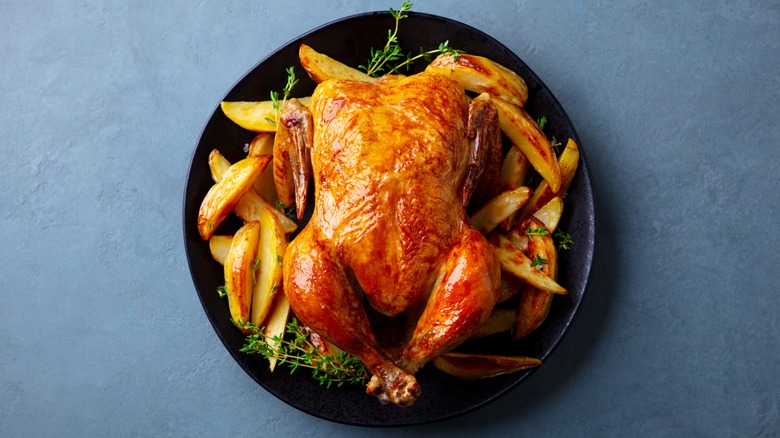The Absolute Minimum Temperature For Safe Chicken
When we talk about food poisoning, chicken is often part of the conversation. Although most of us rely on chicken regularly to help us out with weeknight favorites, it's also a food that comes with a warning label because it can make us sick if not handled properly. Chicken can carry harmful bacteria such as salmonella, staph infections, campylobacter, listeria, and E.coli. Let's just say those can all be as scary as they sound.
Obviously, we want to avoid illness whenever possible, so in addition to safe handling practices when you whip up a batch of tahini chicken thighs or serve your perfect roasted chicken, you'll want to use the right cooking temperature for your meat. Rely on your recipe to guide you to the right oven setting for your dish, which can range anywhere from 325 degrees up to 500 degrees. While the cooking temperature isn't critical for safety, it does impact the estimated cooking time and the essential goal of achieving a minimum internal temperature of 165 degrees. Regardless of whether you cook your chicken on a smoker, or in a skillet, griddle, or air fryer, ensure the meat is cooked through to that minimum.
The risks of undercooked chicken
While many types of meat, like lamb and beef, can be served up after a light brush with the heat, eating raw or undercooked chicken (anything under 165 degrees Fahrenheit) can serve up gastrointestinal issues that range from mild to deadly. To kill the bacteria that can make you sick, all chicken must reach that magical 165-degree mark, or you could be one of the one million people the CDC estimates get sick from consuming contaminated chicken annually.
It's important to remember that, when it comes to food-borne bacteria, chicken just isn't as forgiving as other meats. There's not a lot of wiggle room here, so don't guess whether the chicken has reached the safety threshold. Instead, be sure to use a reliable thermometer and take a reading in the thickest part of the meat to ensure it's cooked completely through. For smaller pieces of chicken, like those tossed into a stir fry or placed in the slow cooker for shredded chicken tacos, make a visual inspection to ensure there are no pink areas, even in the middle of the meat. If in doubt, go ahead and grab the thermometer for verification.
Other safety concerns
The process of safely handling chicken should be a habit that extends from first contact through to the end of the cooking process. Every surface a contaminated chicken comes into contact with before it's cooked can harbor germs that could potentially make you sick. That means those juices can contaminate other food in your shopping cart, in the fridge, or on the counter during meal prep. So before you focus on the ideal oven temperature for roasting chicken and getting an accurate reading of at least 165 degrees, make sure you're not cross-contaminating.
When handling raw chicken packages at the supermarket, wrap them in plastic and place them away from ready-to-eat foods in your cart. After you get it home, put it on a plate or in a container or bowl in the refrigerator so the juices don't escape. If you freeze your chicken before use, note that freezing does not kill germs; only cooking it does. When it's time to cook, isolate raw chicken from the other raw or already cooked foods you are making. Also, wash cutting boards and sterilize the sink after cleaning up items that have come into contact with the raw chicken. Although handling chicken does require a bit more attentiveness than other foods, with proper shopping, storing, and cooking practices, you can safely enjoy it as often as you like.


